Abstract
Twenty infants, mechanically ventilated in the neonatal period for respiratory distress syndrome, were compared with 15 healthy controls, matched for birthweight(less than 1501 g) but greater in mean gestational age. Clinical features and lung mechanics (by whole body plethysmography) were recorded at 6-monthly intervals until about one year. THe neonatal course of the mechanically ventilated infants was commonly complicated by tracheobronchial hypersecretion and the later course by a fairly high incidence of lower respiratory tract illness. In this group, thoracic gas volume, dynamic compliance, pulmonary and airways conductance were all abnormal during the middle 4 months of the first year and reverted towards normal towards the end of the first year. The control group had normal lung mechanics. Early lung function tests were of limited value in predicting later lower respiratory tract illness, which was more common in boys, after neonatal mechanical ventilation for longer than 24 hours or raised ambient oxygen for longer than 5 days. There were few predictive physical signs. In this group of very low birthweight infants, respiratory distress syndrome of sufficient severity to require mechanical ventilation led to significant physiological and clinical disturbances of lung function which lasted into the second 6 months of life and which were particularly severe in those who had recurrent lower respiratory tract illness.
Full text
PDF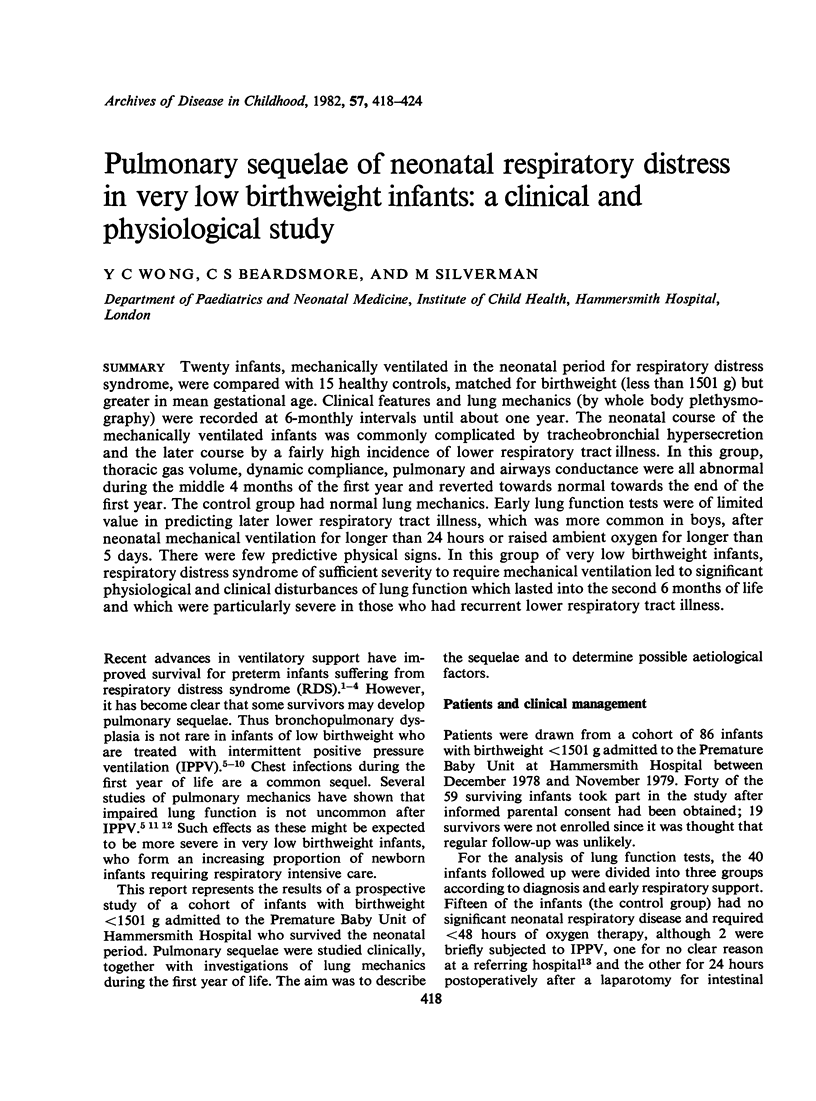

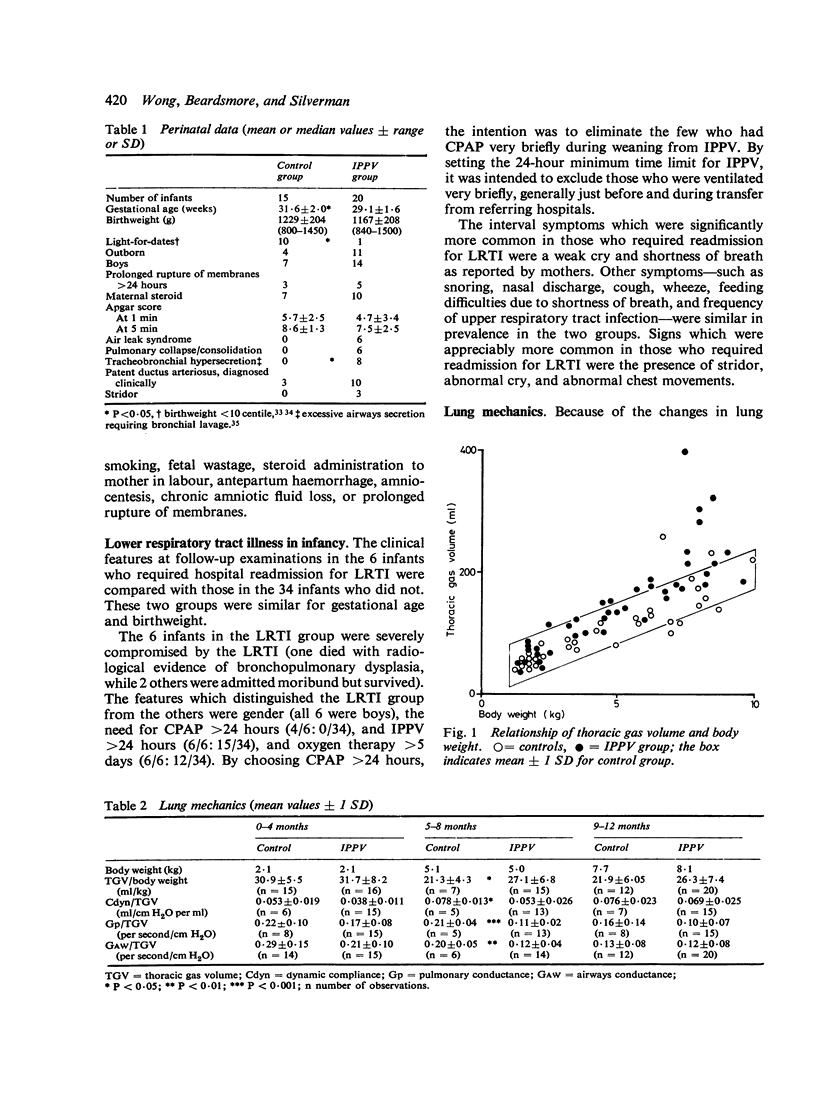
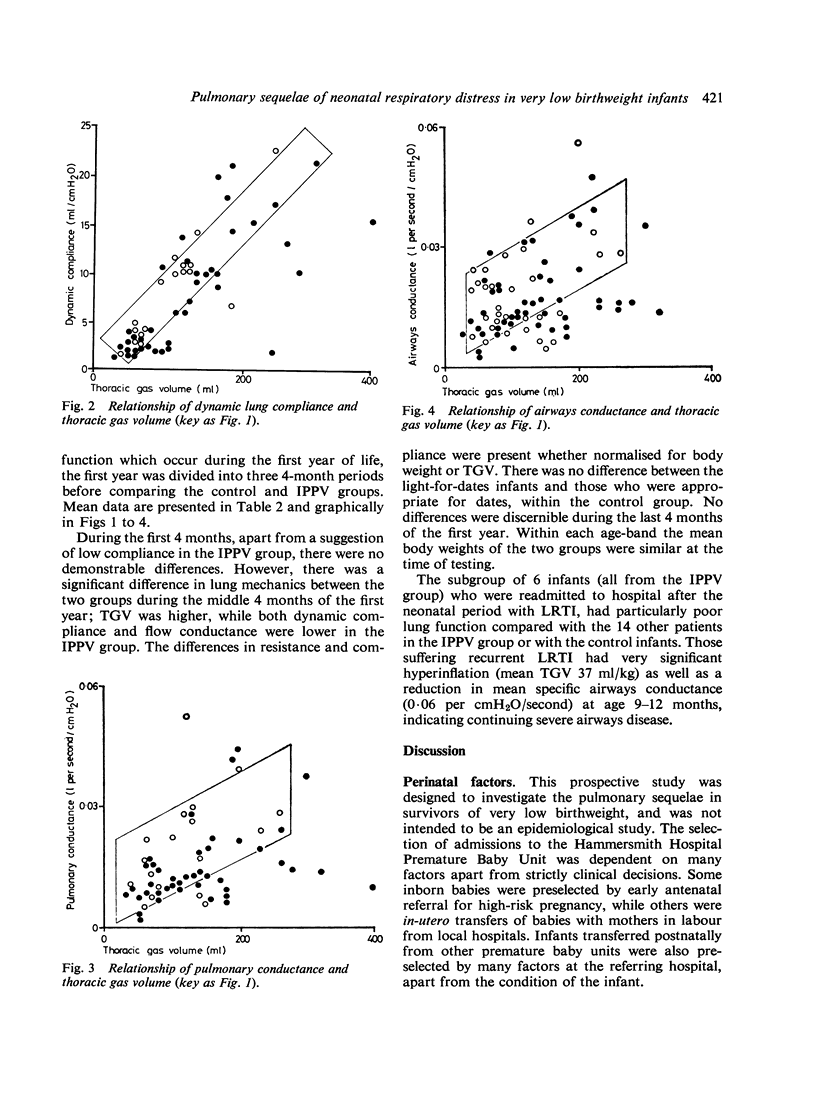

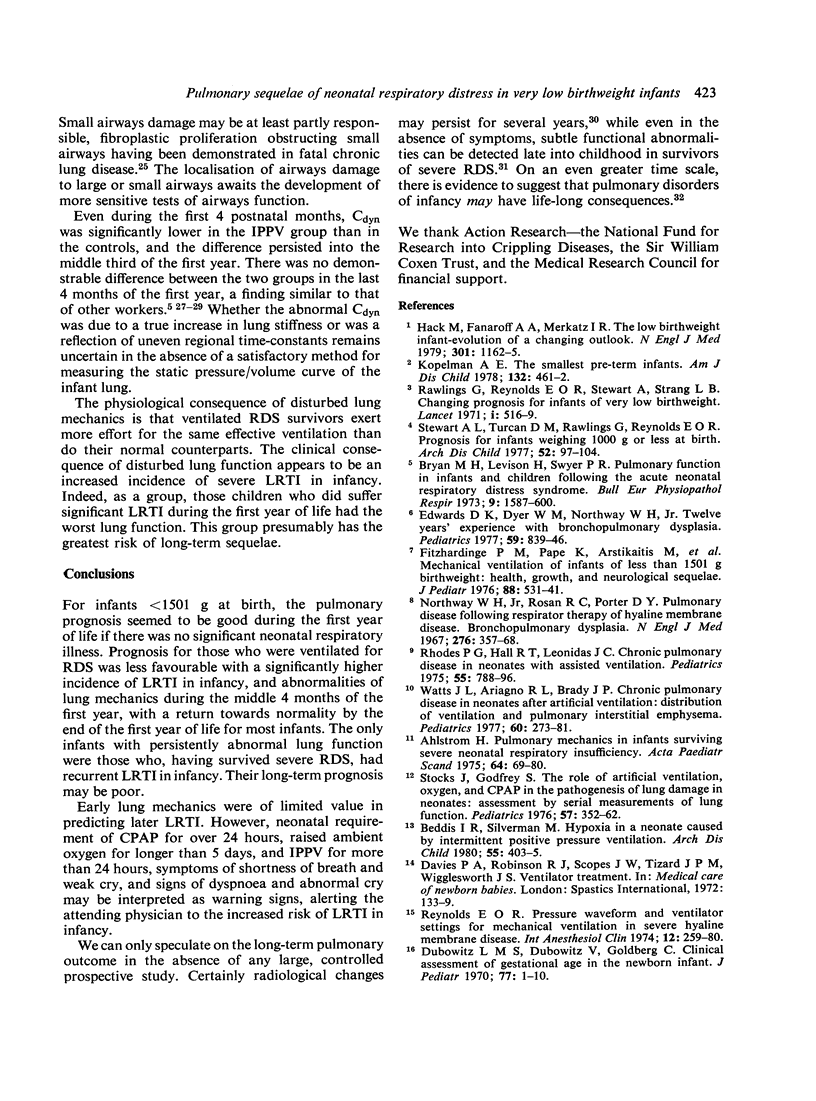
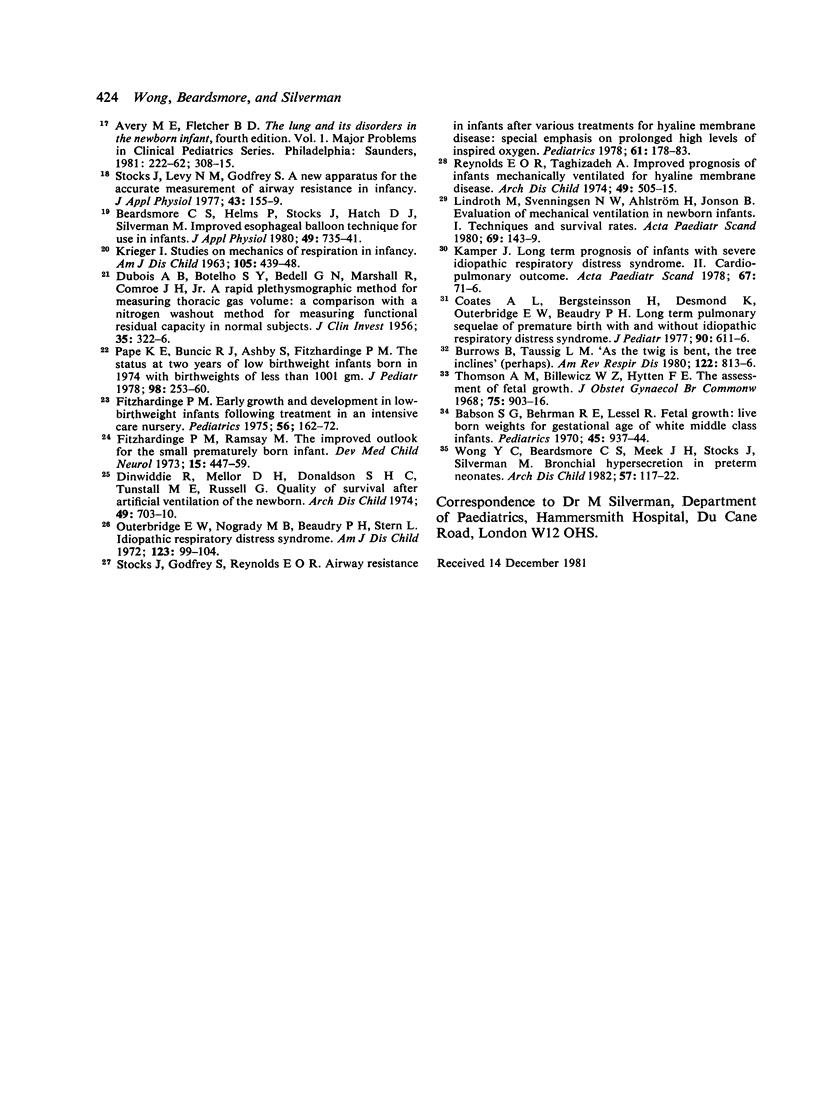
Selected References
These references are in PubMed. This may not be the complete list of references from this article.
- Ahlström H. Pulmonary mechanics in infants surviving severe neonatal respiratory insufficiency. Acta Paediatr Scand. 1975 Jan;64(1):69–80. doi: 10.1111/j.1651-2227.1975.tb04381.x. [DOI] [PubMed] [Google Scholar]
- Babson S. G., Behrman R. E., Lessel R. Fetal growth. Liveborn birth weights for gestational age of white middle class infants. Pediatrics. 1970 Jun;45(6):937–944. [PubMed] [Google Scholar]
- Beardsmore C. S., Helms P., Stocks J., Hatch D. J., Silverman M. Improved esophageal balloon technique for use in infants. J Appl Physiol Respir Environ Exerc Physiol. 1980 Oct;49(4):735–742. doi: 10.1152/jappl.1980.49.4.735. [DOI] [PubMed] [Google Scholar]
- Beddis I. R., Silverman M. Hypoxia in a neonate caused by intermittent positive pressure ventilation. Arch Dis Child. 1980 May;55(5):403–405. doi: 10.1136/adc.55.5.403. [DOI] [PMC free article] [PubMed] [Google Scholar]
- Bryan M. H., Levison H., Swyer P. R. Pulmonary function in infants and children following the acute neonatal respiratory distress syndrome. Bull Physiopathol Respir (Nancy) 1973 Nov-Dec;9(6):1587–1600. [PubMed] [Google Scholar]
- Burrows B., Taussig L. M. "As the twig is bent, the tree inclines" (perhaps) Am Rev Respir Dis. 1980 Dec;122(6):813–816. doi: 10.1164/arrd.1980.122.6.813. [DOI] [PubMed] [Google Scholar]
- Coates A. L., Bergsteinsson H., Desmond K., Outerbridge E. W., Beaudry P. H. Long-term pulmonary sequelae of premature birth with and without idiopathic respiratory distress syndrome. J Pediatr. 1977 Apr;90(4):611–616. doi: 10.1016/s0022-3476(77)80382-x. [DOI] [PubMed] [Google Scholar]
- DUBOIS A. B., BOTELHO S. Y., BEDELL G. N., MARSHALL R., COMROE J. H., Jr A rapid plethysmographic method for measuring thoracic gas volume: a comparison with a nitrogen washout method for measuring functional residual capacity in normal subjects. J Clin Invest. 1956 Mar;35(3):322–326. doi: 10.1172/JCI103281. [DOI] [PMC free article] [PubMed] [Google Scholar]
- Dinwiddie R., Mellor D. H., Donaldson H. C., Tunstall M. E., Russell G. Quality of survival after artificial ventilation of the newborn. Arch Dis Child. 1974 Sep;49(9):703–710. doi: 10.1136/adc.49.9.703. [DOI] [PMC free article] [PubMed] [Google Scholar]
- Dubowitz L. M., Dubowitz V., Goldberg C. Clinical assessment of gestational age in the newborn infant. J Pediatr. 1970 Jul;77(1):1–10. doi: 10.1016/s0022-3476(70)80038-5. [DOI] [PubMed] [Google Scholar]
- Edwards D. K., Dyer W. M., Northway W. H., Jr Twelve years' experience with bronchopulmonary dysplasia. Pediatrics. 1977 Jun;59(6):839–846. [PubMed] [Google Scholar]
- Fitzhardinge P. M. Early growth and development in low-birthweight infants following treatment in an intensive care nursery. Pediatrics. 1975 Aug;56(2):162–172. [PubMed] [Google Scholar]
- Fitzhardinge P. M., Pape P., Arstikaitis M., Boyle M., Ashby S., Rowley A., Netley C., Swyer P. R. Mechanical ventilation of infants of less than 1,501 gm birth weight: Health, growth, and neurologic sequelae. J Pediatr. 1976 Apr;88(4 Pt 1):531–541. doi: 10.1016/s0022-3476(76)80001-7. [DOI] [PubMed] [Google Scholar]
- Fitzhardinge P. M., Ramsay M. The improving outlook for the small prematurely born infant. Dev Med Child Neurol. 1973 Aug;15(4):447–459. doi: 10.1111/j.1469-8749.1973.tb05066.x. [DOI] [PubMed] [Google Scholar]
- Hack M., Fanaroff A. A., Merkatz I. R. Current concepts: the low-birth-weight infant--evolution of a changing outlook. N Engl J Med. 1979 Nov 22;301(21):1162–1165. doi: 10.1056/NEJM197911223012105. [DOI] [PubMed] [Google Scholar]
- KRIEGER I. Studies on mechanics of respiration in infancy. Am J Dis Child. 1963 May;105:439–448. doi: 10.1001/archpedi.1963.02080040441003. [DOI] [PubMed] [Google Scholar]
- Kamper J. Long term prognosis of infants with severe idiopathic respiratory distress syndrome. II. Cardio-pulmonary outcome. Acta Paediatr Scand. 1978 Jan;67(1):71–76. doi: 10.1111/j.1651-2227.1978.tb16279.x. [DOI] [PubMed] [Google Scholar]
- Kopelman A. E. The smallest preterm infants: reasons for optimism and new dilemmas. Am J Dis Child. 1978 May;132(5):461–462. doi: 10.1001/archpedi.1978.02120300021002. [DOI] [PubMed] [Google Scholar]
- Lindroth M., Svenningsen N. W., Ahlström H., Jonson B. Evaluation of mechanical ventilation in newborn infants. I. Techniques and survival rates. Acta Paediatr Scand. 1980 Mar;69(2):143–149. doi: 10.1111/j.1651-2227.1980.tb07051.x. [DOI] [PubMed] [Google Scholar]
- Northway W. H., Jr, Rosan R. C., Porter D. Y. Pulmonary disease following respirator therapy of hyaline-membrane disease. Bronchopulmonary dysplasia. N Engl J Med. 1967 Feb 16;276(7):357–368. doi: 10.1056/NEJM196702162760701. [DOI] [PubMed] [Google Scholar]
- Outerbridge E. W., Nogrady B., Beaudry P. H., Stern L. Idiopathic respiratory distress syndrome. Recurrent respiratory illness in survivors. Am J Dis Child. 1972 Feb;123(2):99–104. doi: 10.1001/archpedi.1972.02110080077003. [DOI] [PubMed] [Google Scholar]
- Pape K. E., Buncic R. J., Ashby S., Fitzhardinge P. M. The status at two years of low-birth-weight infants born in 1974 with birth weights of less than 1,001 gm. J Pediatr. 1978 Feb;92(2):253–260. doi: 10.1016/s0022-3476(78)80020-1. [DOI] [PubMed] [Google Scholar]
- Rawlings G., Stewart A., Reynolds E. O., Strang L. B. Changing prognosis for infants of very low birth weight. Lancet. 1971 Mar 13;1(7698):516–519. doi: 10.1016/s0140-6736(71)91124-x. [DOI] [PubMed] [Google Scholar]
- Reynolds E. O. Pressure waveform and ventilator settings for mechanical ventilation in severe hyaline membrane disease. Int Anesthesiol Clin. 1974 Winter;12(4):259–280. doi: 10.1097/00004311-197412040-00015. [DOI] [PubMed] [Google Scholar]
- Reynolds E. O., Taghizadeh A. Improved prognosis of infants mechanically ventilated for hyaline membrane disease. Arch Dis Child. 1974 Jul;49(7):505–515. doi: 10.1136/adc.49.7.505. [DOI] [PMC free article] [PubMed] [Google Scholar]
- Rhodes P. G., Hall R. T., Leonidas J. C. Chronic pulmonary disease in neonates with assisted ventilation. Pediatrics. 1975 Jun;55(6):788–796. [PubMed] [Google Scholar]
- Stewart A. L., Turcan D. M., Rawlings G., Reynolds E. O. Prognosis for infants weighing 1000 g or less at birth. Arch Dis Child. 1977 Feb;52(2):97–104. doi: 10.1136/adc.52.2.97. [DOI] [PMC free article] [PubMed] [Google Scholar]
- Stocks J., Godfrey S., Reynolds E. O. Airway resistance in infants after various treatments for hyaline membrane disease: special emphasis on prolonged high levels of inspired oxygen. Pediatrics. 1978 Feb;61(2):178–183. [PubMed] [Google Scholar]
- Stocks J., Godfrey S. The role of artificial ventilation, oxygen, and CPAP in the pathogenesis of lung damage in neonates: assessment by serial measurements of lung function. Pediatrics. 1976 Mar;57(3):352–362. [PubMed] [Google Scholar]
- Stocks J., Levy N. M., Godfrey S. A new apparatus for the accurate measurement of airway resistance in infancy. J Appl Physiol Respir Environ Exerc Physiol. 1977 Jul;43(1):155–159. doi: 10.1152/jappl.1977.43.1.155. [DOI] [PubMed] [Google Scholar]
- Thomson A. M., Billewicz W. Z., Hytten F. E. The assessment of fetal growth. J Obstet Gynaecol Br Commonw. 1968 Sep;75(9):903–916. doi: 10.1111/j.1471-0528.1968.tb01615.x. [DOI] [PubMed] [Google Scholar]
- Watts J. L., Ariagno R. L., Brady J. P. Chronic pulmonary disease in neonates after artificial ventilation: distribution of ventilation and pulmonary interstitial emphysema. Pediatrics. 1977 Sep;60(3):273–281. [PubMed] [Google Scholar]
- Wong Y. C., Beardsmore C. S., Meek J. H., Stocks J., Silverman M. Bronchial hypersecretion in preterm neonates. Arch Dis Child. 1982 Feb;57(2):117–122. doi: 10.1136/adc.57.2.117. [DOI] [PMC free article] [PubMed] [Google Scholar]


